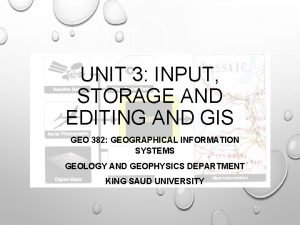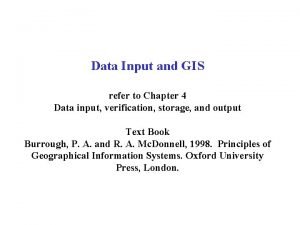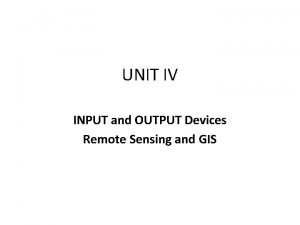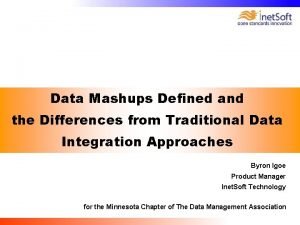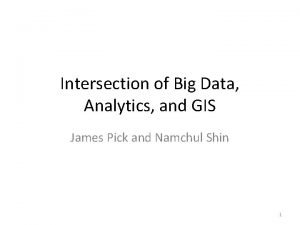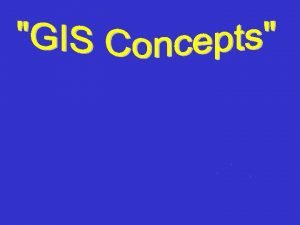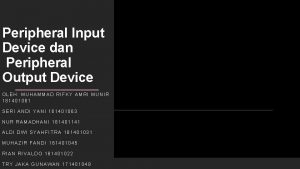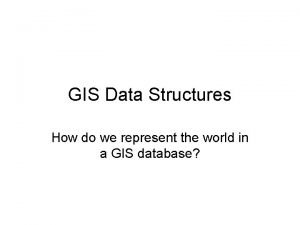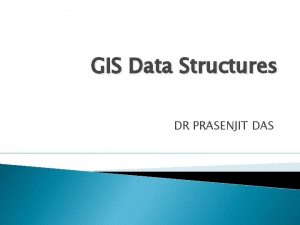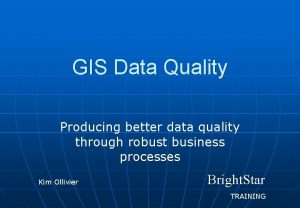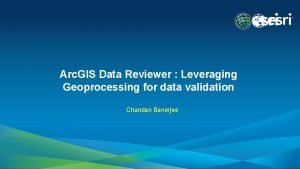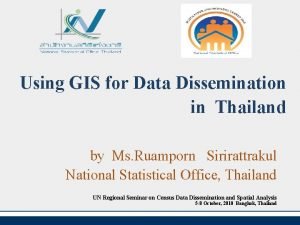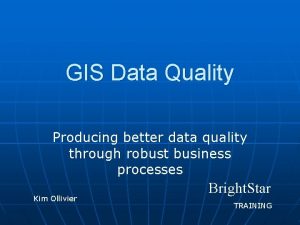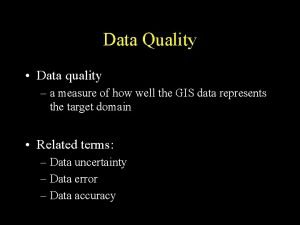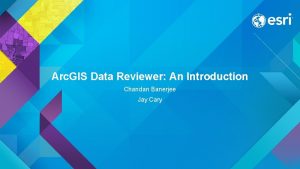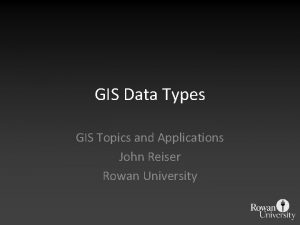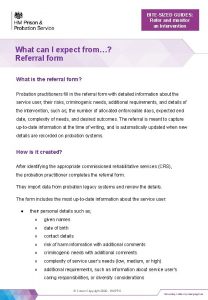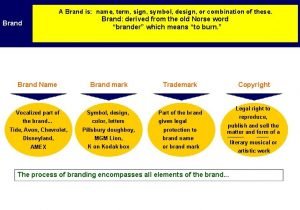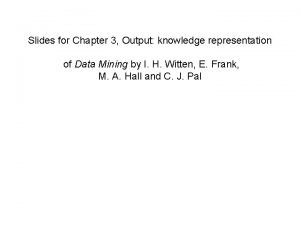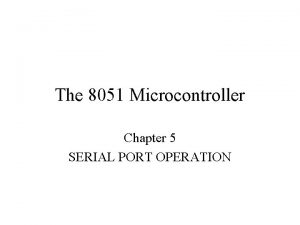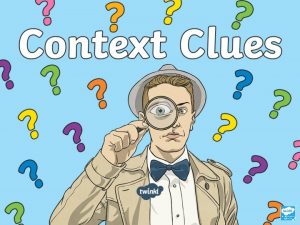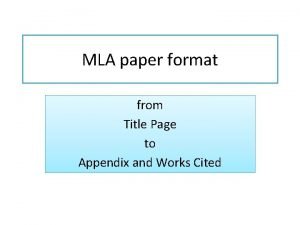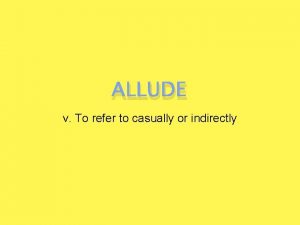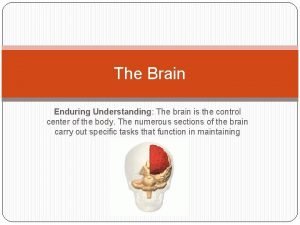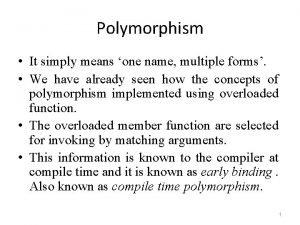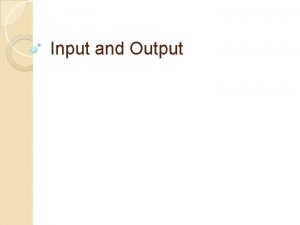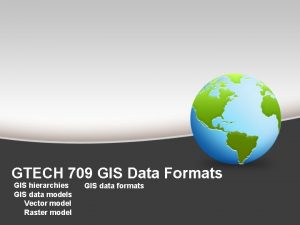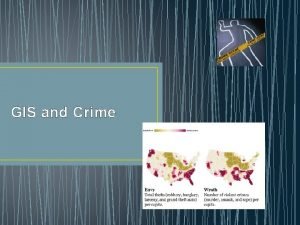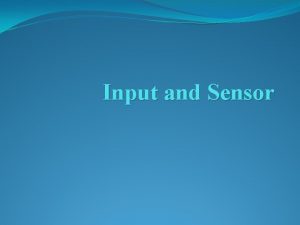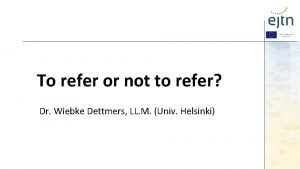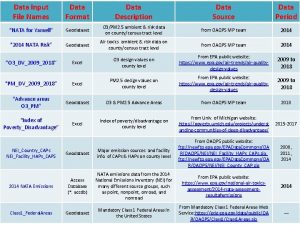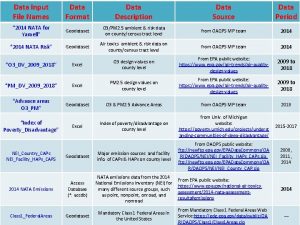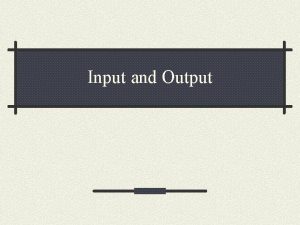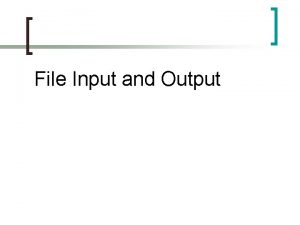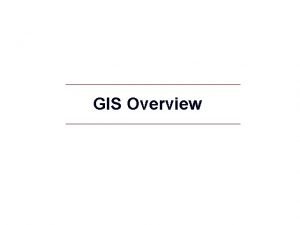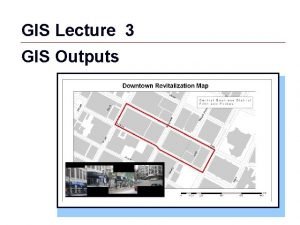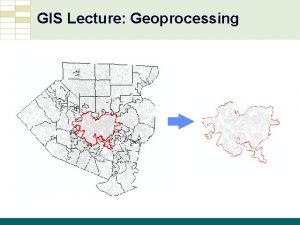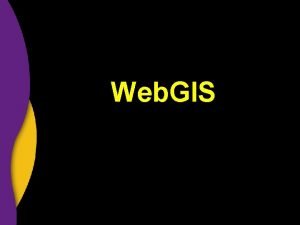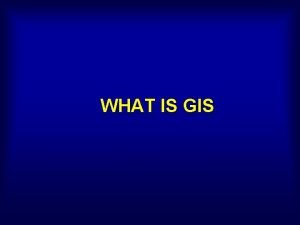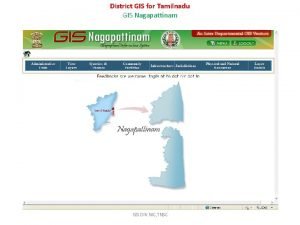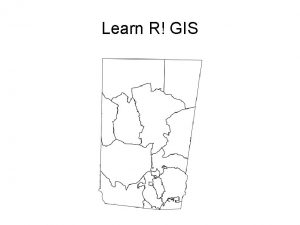Data Input and GIS refer to Chapter 4
































- Slides: 32

Data Input and GIS refer to Chapter 4 Data input, verification, storage, and output Text Book Burrough, P. A. and R. A. Mc. Donnell, 1998. Principles of Geographical Information Systems. Oxford University Press, London.

Overview • • Input of spatial data Modes of data input Rasterization and vectorization Map preparation and the digitizing Remote Sensing: Special Raster Data Input Integrating different data sources External Databases Exercise

Input of spatial data • Need to have tools to transform spatial data of various types into digital format • Data input is a major bottleneck in application of GIS technology. Costs of input often consume 80% or more of project costs • Many commercial GIS operations generate most of their revenue through data input • Data input is labor intensive, tedious, and error -prone • There is a danger that construction of the database may become an end in itself and the project may not move on to analysis of the data collected

Input of spatial data-continue • Essential to find ways to reduce costs and maximize accuracy • Need to automate the input process as much as possible, but: automated input cab create bigger editing problems later • Source documents (maps) may often have to be redrafted to meet rigid quality requirements of automated input • Sharing of digital data is one way around the input bottleneck. More and more spatial data is becoming available in digital form

Input of spatial data-continue • Data input to a GIS involves encoding both the locational and attribute data • The locational data is encoded as coordinates on a particular cartesian coordinate system • Source maps may have different projections and scales • Several stages of data transformation may be needed to bring all data to a common coordinate system • Attribute data is often obtained and stored in tables (Database Management System)

Input of spatial data-continue • There are two methods for spatial data acquisition • Primary methods Surveying, Photogrammetry, GPS, and Remote Sensing • Secondary methods Digitization, Automatic line following, and scanning

The input subsystem • Designed to transfer data into the GIS from external sources (attribute and map data) • Must allow for encoding in either raster or vector(TIN) • Must provide a means for spatial referencing (projections, cartesian coordinate systems, etc) • Must provide link between storage and editing subsystems (ensure input can be saved any errors corrected)

Modes of data input: Input Devices • • • Grid overlay keyboard Digitizer Scanner Data in digital format (Total station, digital photogrammetry, remote sensing, GPS)

Grid overlay • Grid on clear material is overlaid on map • Identity of each cell in the grid is determined by what map features are in a particular cell • Number or code is assigned to each class of map features, and used to label cells in grid • After filling in the grid, numbers or codes are typed into the computer to produce a raster layer • Pretty antiquated method, seldom used

Keyboard • Keyboard entry (X, Y, Z), (Ø, , h), or angle and distance • Input through keyboard is time consuming, but it is more accurate • It is suitable for small areas i. e. when the number of points/lines/areas are limited • Because of its high accuracy, sometimes it is used in applications that need high quality e. g. cadastral mapping

Digitizing: Digitizing Tablet • Tablet composed of a flat surface, in which are embedded a grid of electronically active wires and mouse-like device (puck or stylus) usually with cross hairs. When puck is moved over the tablet, its location is known because the grid of wires senses it location. Puck also has buttons which allow communication with the computer • Grid acts like a cartersian (X, Y) coordinate system. To input data, map is taped on digitizing tablet. Puck is placed over the feature of interest, and message is sent to compute through buttons on puck e. g. , node is used to mark beginning and end of line feature, or point where polygon closes on itself


Digitization • Digitization is a process of converting existing maps to digital form (vector format) • A digitizer is connected to a computer and map features are followed manually • Digitizers are available at different sizes (A 4, A 3, A 2, A 0) and different accuracy (0. 05 mm) • Example of digitizers are Cal. Comp 9500 and Summagraphic

Digitizing-continue • Digitizing the map contents can be done in two different modes: point or stream • Point mode: the operator identifies the points to be captured explicitly by pressing a button • Stream mode: points are captured at set time intervals (typically 10 per second) or on movement of the cursor by a fixed amount • In point mode the operator selects points subjectively, two point mode operators will not code a line in the same way • Stream mode generates large numbers of points, many of which may be redundant

Digitizing- Problems • Paper maps are unstable: each time the map is removed from the digitizing table, the reference points must be re-entered when the map is affixed to the table again • If the map has stretched or shrunk in the interim, the newly digitized points will be slightly off in their location when compared to previously digitized points • Errors occur on these maps, and these errors are entered into the GIS database as well the level of error in the GIS database is directly related to the error level of the source maps

Digitizing- Problems-continue • Maps are meant to display information, and do not always accurately record locational information, for example, when a railroad, stream and road all go through a narrow mountain pass, the pass may actually be depicted wider than its actual size to allow for the three symbols to be drafted in the pass • Discrepancies across map sheet boundaries can cause discrepancies in the total GIS database e. g. roads or streams that do not meet exactly when two map sheets are placed next to each other • User error causes overshoots, undershoots

Scanners • Types of scanners: Line following and drum • Line following placed on a line and follow line using a guiding device such as a laser • Two short comings: – 1. sample lines at regular time or distance intervals (more complex parts of the line should have more samples, less complex need less samples) – 2. lines that converge then diverge (e. g. , contours along a cliff, road intersections, etc), device doesn’t know which line is which also broken lines (dashes, interrupted by label etc. ) • Line following technology can be reproduced in a software environment (line tracing software)

Drum scanners • Drum scanners (Fig 5. 2, p. 129) as the drum rotates about its axis, a scanner head containing a light source and photo-detector reads the reflectivity of the target graphic, and digitizing this signal, creates a single row of pixels from the graphic. The scanner head moves along the axis of the drum to create the next column of pixels, and so on through the entire scan • Systems may have a scan spot size of as little as 25 micrometers, and be able to scan graphics of the order of 1 meter on a side an alternative mechanism involves an array of photo-detectors which extract data from several rows of the raster simultaneously. The detector moves across the document in a swath when all the columns have been scanned, the detector moves to a new swath of rows initially, scanning produces a raster image, which can be converted to vector using on screen digitizing or automated line tracing software

Scanning • Scanning is a process of converting existing maps to digital form (raster format) • A scanner is connected to a computer and map features are scanned automatically • Scanners are available at different sizes (A 4, A 3, A 2, A 0) and different accuracy (300 dpi, 600 dpi, 1000 dpi) • Example of Scanners are UMAX-S 12, HP


Scanners-Problems • Scanners are generally very expensive • Editing can take nearly as long as manual digitizing would have taken • Scanners should be thought of as timesaving devices only when maps are clear, show good contrast, and contain a relatively simple amount of content

Rasterization and vectorization • Regardless of input device, it is necessary to determine if the final product will be raster or vector • Most GIS programs allow conversion between the two, but problems are involved • If vector to raster, cell size is also important, but the results are satisfactory • If raster to vector, lines become blocky and step-like, can’t reverse the procedure to produce original content of vector line also, resolution (or cell size) has a direct effect on the spatial integrity of the object • Spline algorithms - apply a smoothing function to vector lines • Examples of software convert from raster to vector or vice versa are R 2 V and Arc. Scan under Arc/Info

Map Preparation and the Digitizing • Identification of features to be digitized. Sometimes marked directly on the map or on clear overlay. Sometimes, identification of nodes vs. vertices • The digitizing process usually starts with telling the computer about the coordinate system that the map is in. Digitizer operates in its own cartesian coordinate system, need to establish relationship between digitizer coordinates and map coordinates (Transformation) • Registration points or tick marks identified. Allows you to remove map from tablet to allow others to access it, then put it back on and register the input system using tic marks. It is essential to locate these precisely because they provide the reference for all other spatial data entered

Reference Frameworks and Transformations • Digitizer coordinate must be transformed to map coordinates using a minimum number of four registration marks to cater for Translation: Object movement Rotation: Reorient the object Scale change: adjust the object size (Figure 5. 4, p. 133, De. Mers)

Setting up digitizing environment to handle errors • Fuzzy tolerance - attempts to account for errors caused by the "shaky hand”. Based on the idea that you will not be able to place the cursor exactly the same location twice. Essentially defines a distance for maximum separation. If two nodes are within the limits of fuzzy tolerance, the are snapped together. Same idea for line features. Can be done before digitizing starts or can be implemented in post-digitizing editing process • Other variables: Material of map shrink/swell with changes in humidity and temperature and stable medium such as plastic (Mylar) is preferred

What to Input • Define your purpose before hand make sure the data you are using are suitable for the goals of your project and pre-plan carefully • Use the most accurate data, but not data that is too accurate for your purpose • Check to see if data are already available • Keep coverages simple and use the same map to extract different coverages when possible • How Much to Input: – Scale dependent – General rule - more complex features at larger scales require more detail (more vertices, smaller cell size) • Sample more for more information

Methods of Vector Input • Manual digitizing, Registration marks • Location of nodes, lines not become nodes and nodes don’t become just points • Building of topology • Correcting of digitizing errors • Transformation and projection • Adding attribute data • Checking the accuracy of attribute data

Methods of Raster Input • Presence/absence method: If object occurs in a cell (anywhere) it is recorded as present ( simplicity ) best method for coding points and lines (Fig. 5. 6 p. 143) • Centroid of cell method : Presence only recorded if object is at the center of the cell. Disadv. - less simple, requires calculation of centroid, location of object relative to centroid. Generally restricted to raster encoding of polygons • Dominant type method : Commonly used for encoding polygons into raster format. Identified as present if it occupies more than 50% of the cell • Percent occurrence: Not only encodes presence/absence, but % occurrence (Urban/Rural) • Generally, each attribute is recorded as a separate coverage e. g. , one grid of percent urban, one of percent rural, percent water, percent forest, etc.

Remote Sensing: Special Raster Data Input • Remote Sensing data is considered as special raster data (in digital form). Image processing software can be used to extract/classify remote sensing imagery (cover later in the semester) • Attention should be paid to geometric and radiometric corrections and method of classification (supervised/unsupervised), different radiometric, geometric, and temporal resolutions • Institutional problems related to remote sensing data include availability of data (limited coverage, cloud cover), cost, education and training, and organizational infrastructure

External Databases • An efficient method of building a GIS database is to limit the amount of time and cost necessary to develop database • A plenty of data already available in different digital format an in different media 9 -inch tape, 8 mm tape, CD-ROM, etc. • Need to evaluate data for its utility/quality for projects and ability to import • Meta-data or data dictionary should be prepared for the GIS database (information about the content)

Exercise 2: Digitization • 1. Load any image of the campus into Arc. View. • 2. Create three new themes (point, line, polygon) (hint: View/new theme) – a. Create a point theme to show your classroom buildings, where you park, and where you have lunch. – b. Create a line theme of the paths that you walk between those points – c. Create a polygon theme of each building that has a point. • 3. Give a unique id number to each point, line and polygon in each of the new themes tables. (hint: Table/start editing) • 4. Change the legend of each theme to show the different id numbers. • 5. Give the points a new symbol that represent what is happening there. • 6. Give the lines arrows to show what direction you are walking. • 7. Create a layout that has a title, north arrow, your name, date, and a custom legend.

Digitization-continue • To create a custom legend – a. First load the legend into a layout. – b. Second select the legend and right click simplify. (This will separate the legend) – c. Now edit the legend to give it a unique look and take out the polygon theme part of the legend. – d. Once you are finish with the legend select everything in the legend. When everything is selected go to graphics/group. This will group the graphic back together. • 9. In the layout, select File and Export the layout to JPEG format, but before that make sure the JPEG (JFIF) image support Extension is loaded • What to hand in. – 1. Jpeg layout – 2. Layout contains – a. Campus image with three themes – b. Custom legend – c. Title, scale, north arrow and your name
 Keyboard entry in gis
Keyboard entry in gis Gis data input
Gis data input Output device for gis
Output device for gis Data mashups and gis are data integration technologies.
Data mashups and gis are data integration technologies. Google earth
Google earth Characteristics of natural approach
Characteristics of natural approach Big data gis
Big data gis Components of gis
Components of gis Peralatan peripheral
Peralatan peripheral Gis data structure
Gis data structure Gis data structure
Gis data structure Gis data quality
Gis data quality Gis data validation
Gis data validation Giscont
Giscont Data quality in gis
Data quality in gis Data quality in gis
Data quality in gis Gis data validation
Gis data validation Faceb oo
Faceb oo Gis data types
Gis data types Attribute data query in gis
Attribute data query in gis Refer and monitor
Refer and monitor Which of the following is a name term sign symbol design
Which of the following is a name term sign symbol design Input design and output design
Input design and output design Representing input data and output knowledge
Representing input data and output knowledge Serial communication in 8051
Serial communication in 8051 Mean
Mean Example title page mla
Example title page mla To refer to casually or indirectly
To refer to casually or indirectly Cost-benefit analysis quiz
Cost-benefit analysis quiz What does the shaded organ refer to in the diagram below
What does the shaded organ refer to in the diagram below How to explain work ethic
How to explain work ethic One name multiple form refers to
One name multiple form refers to Why do we refer
Why do we refer
